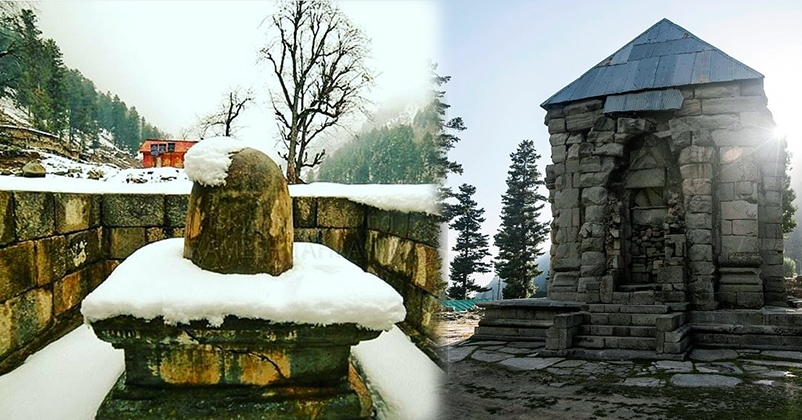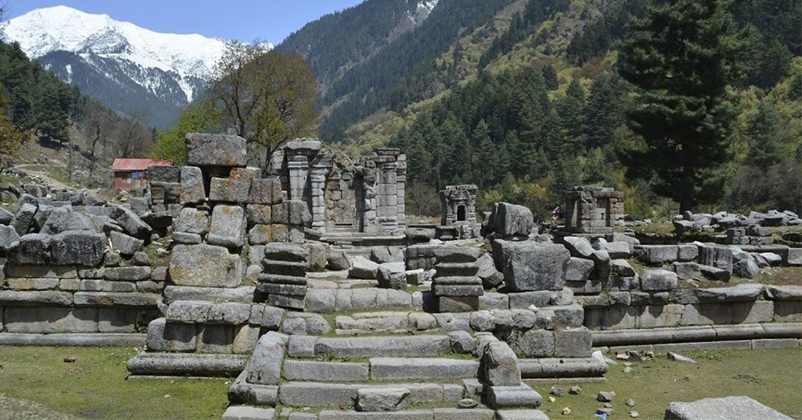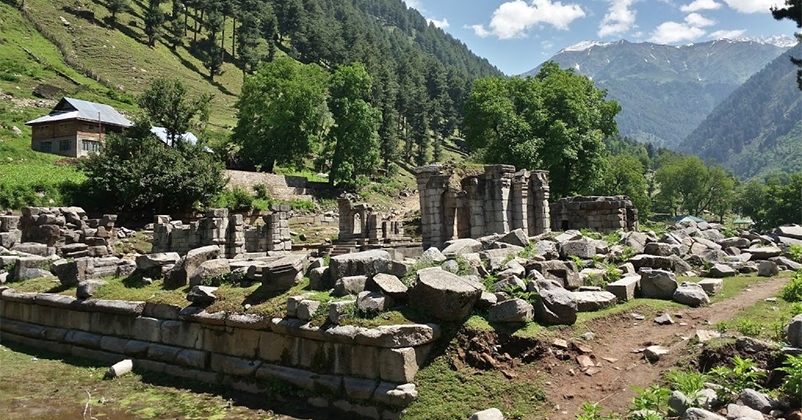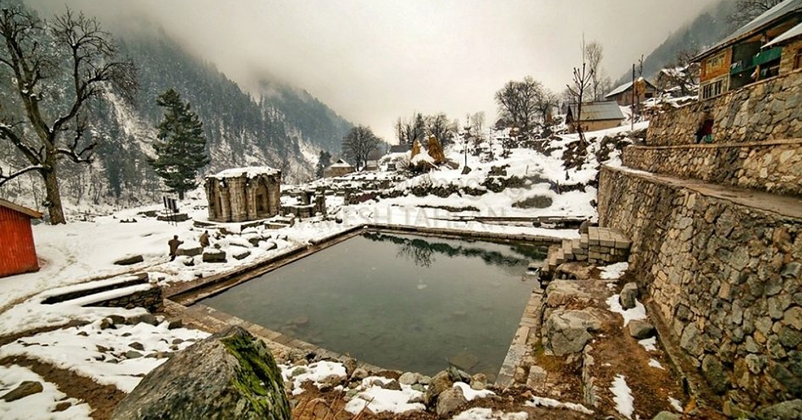Wangath Temples of the Valley; The old ruins of ancient Hindu heritage in J&K
| 22-Sep-2020 |

Rich in cultural and religious heritage, the Union Territory of Jammu and Kashmir has ancient temples which used to be the abode to Hindu gods but today there lies mere ruins of these holy sites due to anti-Hindu forces and Islamic terrorism. Decades ago, with the transformation of political power in the valley in 1339 A.D, the temples and cultural symbols of Hindus came under severe Muslim onslaught. The Muslim rulers owing to their religious orientation and demented commitment to the forcible expansion of Islam, not only desecrated and plundered the temples but also despoiled the Hindu sites manifesting the character of the community's faith and thought. One such ancient stone temple of Kashmir is “Wangath temples”.
Kalhana notes in Rajatarangini, that the town of Srinagri (Srinagar) was built by Emperor Ashoka, in the third century BC. His son Jalauka, 220 BC, built Shaivite temples, Bhutesvara and Jyestharudra and Muthas in the Wangath valley, around the holy spring of Naran Nag, at Buthser.
Wangath (Vangat), is a village situated about forty-eight kilometers north-west of Srinagar. Wangath is the ancient Vashisth Ashram, named after Sage Vashistha. He, as per tradition, stayed here while consecrating the Linga called Jyestharudra at Naran Nag. In Nilmat Purana, Lord Shiva says to Nandi; "You shall live in my company in a place at a distance of one Yojana from here towards east. O Nandi, the gifted sage Vashistha on the earth shall erect your image and also mine at that place."

There is a spring at Wangath, which is known as Naran Nag. In ancient times, this spring was known as Sodara Nag. Around Naran Nag, a complex of temple-ruins is spread. These ruins are known as Wangath temples. The Wangath temples were built in three groups, around the same time as Sankarachar temple at Srinagar and Bumazuv temple near Mattan on Srinagar. Pahalgam road was built.
According to Harmukat-Ganga Mahatmya, the particular region around the spring of Sodara Nag was also known as Bhuteshvara or Shiva Bhutesha---the lord of beings. The entire area is clad with dense forests. The roaring stream of Kanaknai or Karanknadi flows to the south of Sodara Tirtha. It is formed of the tributaries, which flow out from the sacred Nund Kol and Gangabal lakes. The Nilmat Purana describes the spiritual merits of taking a bath in Sodara Nag. It says that a bath in Sodara Nag has a purifying effect on the soul and body. Bishop Crowie and Maior Cole have identified the ruins of seventeen temple structures of various ages and dimensions at Buthser, near Wangath, distributed in two distinct groups; the first, on the western side and second on the eastern side. Each group was enclosed by a separate stone-wall, a short distance away from each other. The temples in the eastern group were known as Rajadainbal. The main temple was dedicated to Shiva-Buteshvara. The temple complex on the western side, known as Nagbal, had the main temple of Shiva-Jyestharudra.
WANGHAT TEMPLE RUINS
The first group of six temples is situated within an enclosure wall. The principal temple is a square of twenty-five feet, it has two entrances opposite each other in the north-east and south-west sides. It has a domed ceiling and the core of the roof consists of rubblestone masonry in lime. The interior measures seventeen feet square. In the centre of the floor is square space, which is unpaved. It marks the site of the pedestal of the image. The two sides, which are closed, are decorated externally with square-topped recesses, each of which contains the pedestal of an image which was probably a replica of the one in the sanctum itself. Eternally the roof is pyramidal. This temple has been identified by Stein, as Shiva-Jyestharudra.

The small temple, to the left, possesses niches on the three sides. The temple immediately touching the porch of the preceding shrine is a single square structure, plain both internally and externally. Behind this is the basement of another small temple. Its super-structure has fallen down. Of the two temples behind, one has its entrance facing south-east and the other faces north-east.
The second group of temples is situated about two hundred yards farther off. It is enclosed in a massive rectangular pierced by a two-chambered gateway. Inside the wall are six structures in ruins and partly buried under the ground. The largest temple has a seventeen feet square base internally and is similar to the largest temple in the first group. This temple has been identified by Stein, as Shiva-Bhuteshvara.
Between the two groups of temples are the number of structures of the third group.An impressive rectangular cistern, almost eighteen feet long, hammered out of a huge boulder, is nearby. Besides, there are remains of a building of a special type, measuring one hundred twenty feet by seventy feet with a height of ten feet. Along with the sides of this structure are over thirty monolithic bases or piers at regular intervals of about twelve feet. It is evident that this was a pillared pavilion.
The Wangath temples are dedicated to Shiva-Bhutesa and Shiva-Ugresa. Close to the temple of Shiva Bhutesha are the remains of the ruins of the temple dedicated to Bhairava ana vatrachakra, seven mothers. Matrachakra or Saptamatrka represents divine energies, which maintain balance in the universe by combating the evil and upholding the good.

According to a legend, Shiva liberated Parvati, Jyestha, from daityas here, and on marrying her took the name of Jyesthesa. In the Jyestharudra temple of Wangath, Shiva is worshipped as linga Nilmat Purana mentions, that the consecration and the first worship of the Jyestharudra linga are distinctly attributed to Rishi Vashistha. Linga was worshipped here under the name of Svayambhuh ie. natural stone and not sculptured one. Cowie identified the base of a giant Linga at the south-west corner of the enclosure.
There are three sites in Kashmir valley, where Shiva Jyesthesa was worshipped under this name or equivalents of Jyesthesvara and Jyestharudra. These are Mount Harmukh, near Tripuresvara, modern Triphar, i,e. between Mahadev and Suresvar and in the close neighborhood of Srinagar. The similar Lingas are worshipped at Sharika ( Hari) Parvat and Suresvari.
Many Hindu kings of Kashmir, from time to time, raised temples at Wangath, around Naran Nag. The earliest evidence about the shrine goes back to 253 BC, when king Narendraditya I, alias Khimkhila was ruling Kashmir. He consecrated shrines of Shiva Bhutesvara and founded a permanent endowment for feeding of Brahmans. His Guru Ugra constructed shrines of Shiva Ugresa and Matrachakra.
According to Rajatarngini, king Jaluka, 137 BC, erected a stone temple at Nandiksetra for Shiva Bhutesa and offered precious stones and other wealth to the temple. The offerings of flowers made of precious metals and stones are mentioned in various Shiva Paddhatis still in use in Kashmir. This temple has been identified with the Shiva-Bhuteshvara temple of Wangath.
Lalitaditya Muktapida, on return from his victorious expeditions, presented a huge sum of his war booty, as an offering shrine. He erected a lofty stone temple of Shiva Jvestha close proximity to the shrine at Wangath and also ma land and villages. King Avantivarman made a pedestal with a conduit for bathing of sacred images (Snanadroni).